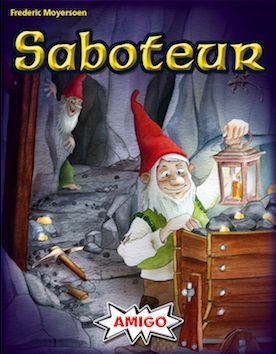Saboteur (2004) Board Game
Saboteur is a card game designed by Fréderic Moyersoen and first published in 2004 by AMIGO. It has become a popular party game known for its blend of bluffing, hidden roles, and strategic gameplay elements. The game has received several expansions and continues to be enjoyed by players around the world.
Game Components of Saboteur
How To Setup Saboteur
To set up the game, place the Start Card and the three Goal Cards on the table, ensuring the treasure card is randomly assigned to one of the Goal Cards and kept face-down. The remaining path and action cards are mixed together, shuffled, and dealt to the players based on the number of participants. The mine entrance card is separated from the middle treasure card by seven card widths, with the other two treasure cards placed above or below, each separated by one card length.
Gameplay Mechanics and Game Objective
– Players take turns playing one card from their hand or discarding it and drawing a new one.
– Path Cards must align with existing cards and cannot be placed sideways.
– Action Cards can block or unblock other players’ actions.
– Miners win if they reach the treasure; Saboteurs win if the treasure is not found.
– The game consists of three rounds, with roles reassigned secretly at the start of each round.
– Winners of each round receive gold nuggets; the player with the most gold at the end of the three rounds wins.
Player Experience
Playing Saboteur involves a mix of strategy, social deduction, and bluffing. Initially, players are cautious and wary, trying to figure out who the Saboteurs are. As the game progresses, the dynamics shift, and open strategizing occurs between the teams. The game creates a narrative arc in each round, starting with methodical movement, followed by suspicion and revelation, and ending in a tense cat-and-mouse scenario. Despite some luck involved in card draws, the game remains engaging and rewarding for clever play.
Pros
Cons
Personal Thoughts on Saboteur
Saboteur is ideal for groups looking for a light, interactive game with a strong social element. It’s a great choice for those who enjoy games with bluffing and hidden identity mechanics. While it may not be as complex as other betrayal games like Battlestar Galactica or The Resistance, Saboteur offers a fun and thematic setting that is easy to jump into and play, making it a perfect filler game between more intense gaming sessions.
We are supported by our audience. When you purchase through links on our site, we may earn an affiliate commission, at no extra cost for you. Learn more.

